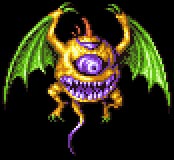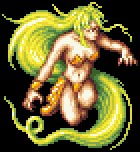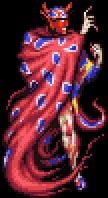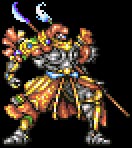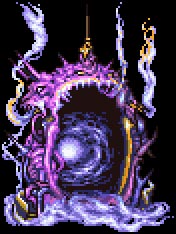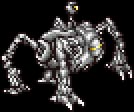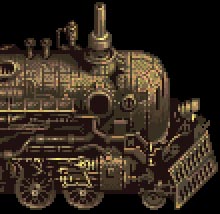cross'o'ver / n. 1. Point or place of crossing. 2. Overlapping, esp. from one style or genre to another.
This page is dedicated to the miscellaneous crossovers that find themselves in several or all of the games in the series. Unlike commonalities that stay from game to game, like potions, white mages, summoned monsters, and Ultima Weapons, these crossovers are related to characters, settings and story, not gameplay. They have their own sections below. For corrections/additions, go here.
Almost every Final Fantasy, in some way, has three music themes in it.
Prelude: this was the first tune anyone ever heard when popping any Final Fantasy game into a console system. Its soaring melody has been ingrained in our thoughts. The NES preludes were only a single instrument; SNES and later versions had another line of music over the top after several bars without it. It's curiously absent in its entirety from FF8, although some of it plays during the "game over" music (The Loser) and in the ending. FF9's Crystal World is a remix. FF10 has an upbeat, disco arrangement. Tactics also only has a small variation on Prelude; it plays after winning a battle. MQ does not have Prelude in it. FF11 plays it when you first open the client and while you receive updates.
Final Fantasy: this song always appears in the introduction, the ending, or both. It does not appear in FF10, Tactics or MQ.
Victory Fanfare: This has remained more or less unchanged from FF1 through FF6. However, FF7, FF8, and FF10 only kept the first few trumpet bars after winning battles (FF7 had a subdued version of the full Victory Fanfare playing after winning a Chocobo Race). It was absent from MQ and Tactics.
In addition, the battle themes from FF1 through FF6, as well as FF9, start with the same strain of music.
Finally, the Chocobo Theme appears in some way in every numbered FF, starting with 2. Each game has a different version of the Chocobo theme, like Samba de Chocobo, Electric de Chocobo, etc. FF7 has four different Chocobo themes! (Fighting, riding, racing, and waltzing. O_o)
Every Final Fantasy game in the numerical series has had the same main logo. In this logo, the title is always underlined in a high roman typeface in black on white, with the Japanese translation under the underline. There is also background image related to the game's plotline that has a washed-out, watercolor look, which obviously changes with each game. This logo has been the standard since FF4, but the re-releases of games on Game Boy Advance included revised logos with this motif. The logos for Mystic Quest, Crystal Chronicles, Legend of the Crystals, and Last Order have the same font but don't include a watercolor picture. The following games do not have the traditional logo: Before Crisis, Dirge of Cerberus, Crisis Core, FF: The Spirits Within, FF: Unlimited.

FF1 - Garland or a light warrior |

FF2 - Emperor Paramekia |

FF3 - Knight job class |

FF4 - Kain |

FF5 - A Hiryuu/Dragon |

FF6 - Terra in Magitek Armor |

FF7 - Meteor |

FF8 - Rinoa and Squall embracing |

FF9 - The Crystal |

FF10 - Yuna performing The Sending |

FFX-2 - Yuna, Rikku, and Paine |

FF11 - A slew of playable characters |

FF12 - A Judge |
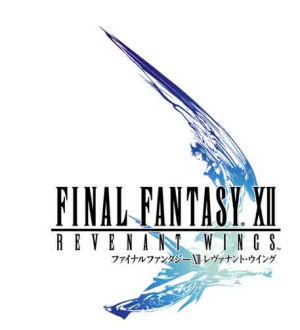
FF12: Revenant Wings - ??? |

FF13 - |
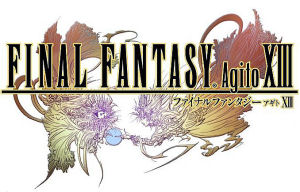
FF13 Agito - ??? |

FF13 Versus - ??? |

FF: Tactics - Ramza and some playable characters |

FF: Tactics Advance - A Judge on a Chocobo |
NOTE: The logo for FFVII: Advent Children duplicates the FF7 logo, but it looks like a graphical mask over some sort of chemical diagram. This shape is a motif in the movie, showing up in a statue in Edge, and in Cloud's sword.
In many games, Squaresoft tries to sneak in pictures of a stone stern-looking face. This face has been postulated to be the Moai, mysterious stone creations scattered all over Easter Island. However, the appearances of these faces is random, and without any meaning in the FF Universe.
In 1976, the Viking 1 Orbiter, while taking pictures of possible landing sites for the Viking 2, came upon a Martian landform that looked remarkably like a face. Much speculation rose about this photo, ranging from being a natural mesa to being a monument by ancient extraterrestrials. For our purposes, this looks remarkably like the Final Fantasy Moai, compounded by the fact that its first appearance was on the moon in FF4.
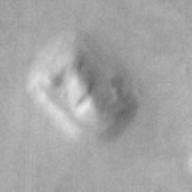
Later, hi-res pictures taken of the same site revealed the formation to actually have little resemblance to a human face. Most of the resemblance in the first photo is due to errors in the photography. It is, in fact, simply a mesa with a large rock formation in the middle. Thanks to Scavenger 382, webmaster of the RPG Compendium for pointing this out to us.
 | FF4:
The Moai on the moon. |
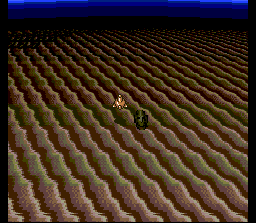 | FF5:
The Moai under the water. |
  | FF7:
The Moai at great glacier.
The Moai in the Chocobo Racing Arena. |
 | FF8:
A huge number of invisible "stone faces" were part of the optional Obel Lake quest. Also, a UFO carries a Moai in the PuPu side quest, as seen in the picture. |
If you've found other Moai faces in FF games, send them to us.
NOTE: The Moai is hardly an FF-only phenomenon. The original Moai are from Easter Island and show up all over the place. These appearances are definitely NOT references to Final Fantasy (the Moai face is quite possibly the most obscure FF in-reference there is). So unless it's extremely blatant (like the Secret of Mana instance mentioned in Ex-Crossovers) please do not send in any Moai crossovers.
EXCALIBUR
Excalibur was named after the sword King Arthur pulled from the stone. In Final Fantasy, this is often the best weapon for a Knight or other Fighter-type class. It is two-handed, inflicts holy-elemental damage, and can either come through a side-quest or treasure chest, or normal progression. Usually, it's not too hard to encounter.
FF3 - A holy-elemental sword in a stone found after encountering Kunoichi. It says "Can you withstand my light?"
FF4 - Cecil's second-best weapon, holy-elemental. He receives this after giving Kokkol, the blacksmith dwarf, the Legend sword and Adamant.
FF5 - A holy-elemental sword.
FF6 - A holy-elemental sword.
FF8 - Wielded by Gilgamesh, his second-best attack
FF9 - A holy-elemental weapon for Steiner, and teaches Climhazzard. There is also an Excalibur II, even more powerful than the Ragnarok, if the player can reache Terrace in Memoria in twelve game hours. The description says "The ultimate sword, used by a legendary king. It was forged in another world."
FF10 - A sword which has the "Break Damage Limit" attribute
FF11 - A relic sword usable by the Red Mage or Paladin.
FF12 - One of Gilgamesh's swords.
FFT - Cidolfas joins your party with this sword.
FFTA - A knightsword sword that does holy damage. Also an Excalibur2.
MASAMUNE
Since FF1, there has been a weapon called the Masamune in every game. Normally, this would be listed in the weapon section, but the Masamune has played a number of different roles in games besides just being a weapon. It also plays a prominent role in Chrono Trigger, a Squaresoft game released around the time of FF6 and FF7.
FF1 - The best weapon, and unlike most others, this can be equipped by any class, including those that can't use swords.
FF2 - A powerful sword.
FF2 - A powerful sword.
FF4 - A powerful katana for Edge.
FF5 - One of the sealed weapons.
FF6 - Most powerful weapon for Cyan, which was renamed "Aura" in NA.
FF7 - Sephiroth's weapon of choice.
FF8 - One of Gilgamesh's weapons that delivers massive damage.
FF9 - One of Zidane's weapons, appearing as a double-bladed katana.
FF10 - Auron's celestial weapon.
FFX-2 - Although not named, Rikku's Dark Knight uses Auron's celestial weapon.
FFT - Wielded by Ninjas.
FFTA - Wielded by Assassins. Later in the game, the Masamune 100 shows up with the legend that it will not dull for one hundred years.
FFCC - An artifact that increases strength.
EXCALIPOOR
Unlike the Excalibur, which is often an exceptional two-handed sword, the Excalipoor is the exact opposite. It first premiered in FF5, when Gilgamesh, thinking he was using the Excalibur, used it (then named Excalipur), only to find it did minimal damage.
FF5 - A weapon of Gilgamesh used near the climax of the game, which delivers humorous results. Low attack power, but causes massive damage when thrown.
FF8 - One of Gilgamesh's four random attacks, this one only does one point of damage.
FF9 - One of Zidane's weapons.
FFT - An imitation of Excalibur, but noted for its fine craftmanship.
SAVE THE QUEEN
Typically used by paladins or noble characters. In Quistis' case, it was a chain whip, but it is usually in the form of a sword. In Kingdom Hearts and Kingdom Hearts II, Donald's weapon, a magic staff, is also called "Save the Queen". In addition, Goofy's best weapon, a shield, is called "Save the King".
FF8 - Quistis' best weapon.
FF9 - Beatrix's (only) weapon.
FF11 - A Paladin's sword that enhances the effect of Cover and grants accuracy bonuses.
FFT - A Knight's sword.
FFTA - A sword for Paladins.
FFCC - An artifact that increases strength.
RAGNAROK
Like Excalibur, this is a two-handed weapon that appears frequently in the series. It has no real special characteristics, only that it is extremely powerful and typically found at the end of the game. In FF8, Ragnarok was the name of the spaceship. In FF6, Ragnarok can also be used as a summon. Also it is the name of one of Sora's special attack/abilities in Kingdom Hearts.
FF3 - The best weapon, and unlike most others, this can be equipped by any class, including those that can't use swords.
FF4 - Cecil's best weapon, renamed "Crystal Sword" in FF4 EasyType NA.
FF5 - A weapon guarded by Shinryu.
FF6 - When obtaining this magicite, the user has a choice to make it a weapon or a summon. The weapon can cast Flare randomly.
FF7 - Cloud's second best sword, next to Ultima Weapon.
FF9 - Steiner's best weapon.
FFX-2 - An accessory that causes MP cost to be 0.
FF11 - A two-handed relic weapon for the Warrior, Paladin, or Knight.
FFT - An upgradeable knightsword.
FFTA - A regular sword. There is also a "Nagrarok" weapon that is much more powerful.
Several character names make appearances in many FFs.
CID
There's been a Cid in every Final Fantasy (excluding MQ) since FF2. These Cids are usually old, brilliant men who frequently control the airships and have high aptitudes for engineering. Cid was playable in FF4, FF7, and Tactics.
 |
 |
| FF2: Cid - The creator and owner of the world's only airship, the Dreadnought, lives in Poft. He gives rides for overblown charges. Much later in the game, after an attack by Paramecia's Whirlwind, he gives the airplane to the heroes with his last breath. |
FF3: Cid - The funny-looking engineer is the mastermind of airships on the Floating Continent. This overblown little man works for the king of Argass and utilizes the Time Gear to make airships. He was stuck in Kazus under the spell of Jinn (causing him to become a two-dimensional ghost), but was helped out by the Heroes. |
 |
 |
| FF4: Cid - The mastermind behind Baron's Red Wings airship squadron, he's a crusty man, fairly old, who nevertheless has the work ethic of an entire anthill. He overworks himself several times throughout the game, risking his life, but he's tough as nails. He lives with his daughter in Baron Town. |
FF5: Cid Previa - A mechanical genius, Cid was the one who built Karnak's Fire Ship. Because the Crystal began to fail, they locked him up. Bartz (who was locked up in an adjacent cell) escaped with his help. Later, Cid and his grandson Mid (who followed in his footsteps) take up residence in a Ranka ruin called the Airship Base; they were the brains who got the Airship up and running. |
 |
 |
| FF6: Cid - The brains behind the Magicite operation, he works wonders for the Empire before realizing just what they're planning on doing with it. After meeting Locke and the gang, he quits his day job and joins the Returners. He's known Celes since she was a child and sees her as a daughter or granddaughter. |
FF7: Cid Highwind - A rough, crusty middle-aged aviator. His dream was always to go into space, but thanks to a bit of extra spot-checking by his underling Shera, who put herself in danger to make sure the launch went through, he ended up scrapping the whole project. He never really forgave her. His technological prowess, like all Cids, is unmatched. He can pilot anything. He uses a spear in battle and he's never without a cigarette. |
 |
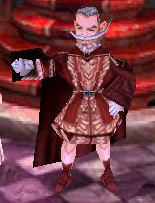 |
| FF8: Cid Kramer - He looks too nice to head a military academy, but there he is. He can be quite forceful when push comes to shove, but he's a bit of a coward. He started the orphanage with his wife Edea, but was forced to transform it into Garden when she was possessed by Ultimecia. Having to live with the fact that he might have to order his wife's death is not a nice feeling. When danger from Galbadia threatens, he runs. Since Garden becomes mobile later in the game, he could be considered to be in charge of an airship. |
FF9: Cid Fabool IX - The ruler of Lindblum and airship genius extraordinaire... well, he would be, except that his wife Hilda turned him into an oglop because he carried on an affair. An attempt at restoring him midway through the game just turns him into a frog. Shame, because he can't think well without his human brain. He's still an expert at Tetra Master, though. Dagger calls him "Uncle Cid". |
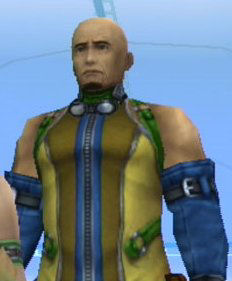 |
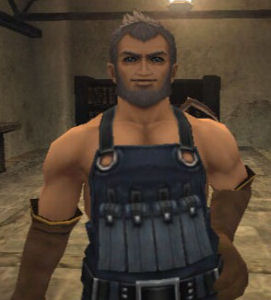 |
| FF10: Cid - The leader of the Al Bhed is bald as a billiard ball and speaks like Yosemite Sam. He cares deeply for his niece Yuna and his daughter Rikku, and is fiercely protective of them. He's a whiz with machina, like all Al Bhed. Strong, cynical, and quite the hard-liner. In X-2, Cid finds it useful to parade the Zanarkand Ruins as a tourist attraction. Yuna gets annoyed by this and (if you like) tells him off. He spends most of the game sulking in the Thunder Plains, at which point he has to get rescued by his daughter and niece from a nasty monster. After this, he comes onboard the Celsius and makes a pain out of himself fighting with Brother et al. |
FF11: Cid - An engineering genius, and figured to be the smartest man in the world. He originally made his fortune from studying ancient Zilart technology and using it in his inventions. When he found a mysterious crystal in the Northlands, he sent the ill-fated mission there to see if there was more. This piece actually turned out to be a chunk of the Star of Tavnazia. Using the knowledge he gained from his studies, he developed a crystal engine that would eventually power airships. The Archduke of Jeuno commissioned him to build a fleet of airships to be used in the Crystal War, but only one was ever publicly used or needed. |
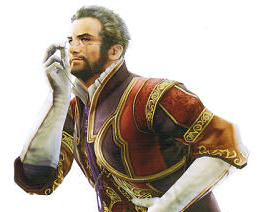 |
 |
| FF12: Doctor Cidolfus Demen Bunansa - This Dr. Cid is one of the main villains of the game. As usual, he is a technological genius, but here takes it way too far, largely deteriorating into insanity. Much of that is probably due to the influence of Venat, who is usually invisible. |
Tactics: Cidolfas Orlandu - Also known as "Thunder God Cid", he leads the Nanten Knights and has done so since the Fifty Year War. An extremely powerful swordsman who has mastered all of the available sword techniques. He was framed by Delita for Goltana's assassination and joins Ramza in his battle against Delita and the Church's Zodiac Braves. |
 |
 |
| Tactics Advance: Cid Randell - Mewt's father in real life becomes the Judgemaster in Ivalice. It's just what he needs to perk his spirits up after his wife died, because back in the real world he cuts a pretty pathetic figure. However, his ethics are superb, and he goes as far as to cut himself off from the palace (and his "wife" and son) to ensure that no one is above the law. After finishing all 300 missions, Cid will join Marche to sock it to a bunch of renegade Judges. |
TSW: Professor Sid - The man who made bio-etheric energy possible, Sid is a gentle man dedicated to getting rid of the Phantoms with minimal possible damage to the Earth itself. He has a great fondness for his assistant Aki, and a respect for the pain she goes through. He is deeply insightful into many things in life, and is seldom wrong. When he is, though, he admits it genially without a shred of ego. |
 |
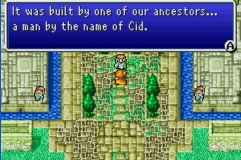 |
| Unlimited: Cid - This version's Cid is a cheerful, optimistic, and energetic technician, a wizard at anything electronic. He carries around weird high-tech equipment and inventions wherever he goes. He names his inventions after females and has a way-too-close connection with them. |
Dawn of Souls: Cid - Not really a character, but Cid is mentioned in GBA's FF 1 & 2: Dawn of Souls. After you learn to speak Lufenish, a man says a long time ago, a man named Cid built the airship. |
BIGGS & WEDGE
Characters named Biggs and Wedge have been in 6, 7, 8, 10/X-2, 12 (where their names were anagrammed to Deweg and Gibbs), and TA, and also have cameo roles in Chrono Trigger, another Squaresoft game. See Star Wars Crossovers for more information.
CHARACTER CROSSOVERS
Cloud from FF7 reappeared as a playable character in Tactics.
Aeris also appears there but is only called the Flower Girl.
Gilgamesh from FF5 reappeared as a summon in FF8. He also appears in a few places in FF9, where he's also called Alleyway Jack. He plays a prominent role in FF12.
Gogo appeared as a boss in FF5 and a playable character in FF6. Nevertheless, he is two different characters in these games who only have two things in common: their propensity to wear loud clothes, and their Mimic class. Perhaps they're distant cousins.
The Magus Sisters: Cindy, Mindy and Sandy from FF4 also appear as powerful summons in FF10/X-2. They also *may* make an uncredited appearance in FF9 - there are three statues in Alexandria (to the right of the ticket booth.) One's short, one's fat, the other tall and lithe. However, there's no actual proof that this is an intentional crossover. In TA, there are three lamias called Mindy, Cindy, and Sandy as well.
CAMEO CROSSOVERS
Lone Wolf, the thief, is behind bars in both FF5 and FF6.
Boko the Chocobo, Bartz's buddy in FF5, is the Chicobo belonging to Squall in FF8, and rescued by Ramza and Agrias in Tactics. The Japanese "initials" (first syllables) of Bobby Corwen, the Chocobo in FF9, is "Boco". (sent by CSW Khan)
Hein, the sorcerer bad guy in FF3, has the same name as the "father of sorceresses" in FF8 in a completely different context. It just possibly may have another crossover in the form of General Hein from FF: The Spirits Within (they're pronounced the same).
- There are no crossovers. It's the first game!
- Unei may be a reference to Dr. Unne in FF1, despite being different genders. (sent by PaleDim)
- "Rally-ho/Lali-ho", the cry of the dwarves, is repeated in FF4, as well as FF5, FF9, FF1 (PSX version). (sent by Moogle Fan)
- The town of Mysidia originall appeared in FF2, but they have no relation to each other.
- In the PSX versions of FF5 and FF6 (FF Anthology), characters will walk back and forth during the save/load screen. Some of the characters in FF5 are Cloud and Sephiroth from FF7.
- "Rally-ho/Lali-ho", the cry of the dwarves, is repeated in FF4, as well as FF5, FF9, FF1 (PSX version). (sent by Moogle Fan)
- The middle name of King Tycoon is Highwind. Highwind is also the last name of Kain the Dragoon in FF4. (sent by Michael F.X. Durant)
- In the PSX versions of FF5 and FF6 (FF Anthology), characters will walk back and forth during the save/load screen. Some of the characters in FF6 are Squall from FF8 and the Onion Knight from FF6.
- In the PSX version, Setzer's Slot command will cause three airships to initiate the "Highwind" attack. Highwind is also the last name of Kain the Dragoon in FF4 and the middle name of King Tycoon in FF5. (sent by brad russell)
- Gau is a boy raised in the wild who cannot speak properly, but can talk to animals. Guy from FF2 was also raised in the wild, has low intelligence and communication skills, and can talk to beavers.
- The summon Stray in FF6 is called Cait Sith in Japan. The little kitty does look a lot like the cat part of Cait Sith from FF7.
- In the play at Gold Saucer during Cloud's date scene, the princess' name is Rosa - possibly a nod to Rosa from FF4. (sent by lata)
- One of the signs on the pile of rubble just after you meet Aeris reads "Mt. Kolts", the name of the mountain range in FF6. (sent by Magus82)
- Vincent's final Limit Break in FF7 lets him turn into a winged creature called Chaos, reminiscent of FF1's final boss. (sent by Joona Kaikkonen)
- Cid's last name is Highwind. His final limit break in FF7 is caleed "Highwind". It summons his airship, named the Highwind, via remote control to launch a missile strike against the enemy. Highwind is also the last name of Kain the Dragoon in FF4 and the middle name of King Tycoon in FF5. (sent by Michael F.X. Durant)
- Sephiroth shares a move with Kefka, the final boss of FF6: Heartless Angel, which reduces all HP to 1. He keeps this move in his incarnations in Kingdom Hearts and Kingdom Hearts 2.
- Loz's cell phone ring tone is the same as the FF7 Victory Fanfare.
- There are several signs for the World Regeneration Organization (W.R.O.) which plays a much larger part in Dirge of Cerberus.
- Early in the movie, when Tifa takes a call in Cloud's office, the cover for the PSX version of FF7 can be seen on the wall.
- One of the pilots on the Shera says that she's raising a chocobo named Boco. This was also the name of Bartz's chocobo in FF5.
- The FF6 summon Bismark has the same name as Irvine's weapon (spelled Bismarck) from FF8. Both names come from the same place (See Summon Name Origins). (sent by J4K0)
- Leon from FF2 was originally known as Lionheart. There are several parallels to Squall Leonhart. First, his name in Kingdom Hearts is plain old Leon. His best weapon in FF8 is called Lionheart (and it's also the keyblade you win from him in KH). (sent by someguy90)
- In Esthar, there's a shop called "Cloud's Shop". Could it be that Cloud?
- The sword used by Ultima Weapon looks a lot like Cloud's Ultima Weapon sword. (sent by Squallzidane89)
I've heard that some of the references in FF9 were lost in the translation; if anyone knows of some of these, please E-mail us!
- Cornelia, the lead in the play "I Want To Be Your Canary" in FF9, has the same name as the first town in FF1 (Corneria). However, the name was more likely taken from King Lear; see Ex-Crossovers. (sent by Ambyrr22)
- Along the same lines, Dagger's real name (found via a secret in the eidolon wall in Madain Sari) is Sarah. There are two other Princess Sara/Sarah's in the series, one in FF1 and one in FF3. It says that Dagger's mother's name was Jane; in FF1, Jayne/Jane was Sarah's mother, the Queen.
- During the kidnapping sequence near the beginning of the game, Garnet can be seen wearing a robe which looks very close to the clothing of a White Mage.
- In Memoria, there is a secret sword - Excalibur II - that can only be found if you get to it in under 12 hours. When you find it this message will appear:
"To Brother Gil: Bro, I found the sword, like you told me. But there were two. One of 'em had a lame name, something II. It was a dingy, old thing with flashy decorations, something you'd probably like. So I went with Excalipur. I'll be back after I find the Tin Armor."
"Brother Gil" refers to Gilgamesh, as does the existence of an Excalibur along with an Excalipur that appears to be just as powerful. This is directly taken from the battle with Gilgamesh in FF5. (sent by Thomas Hall)
- Queen Stella shares a name with Stella from FF5... although I believe that's just coincidence. (sent by Schwarzer Engel)
- Terra's "limit break" move in FF6 (JP) was called "Trance". This is reflected in FF9's limit break system, which is also called "Trance". (sent by Joey Martin)
- "Rally-ho/Lali-ho", the cry of the dwarves, is repeated in FF4, as well as FF5 and FF1 (PSX version). (sent by Moogle Fan)
- In Evil Forest, one of the Active Time Events (A.T.E.'s) is called "Orchestra In The Forest". It depicts the Tantalus orchestra playing a tune to keep their spirits up. The tune is Rufus's Welcoming March from FF7.
- One of Freya's skills is called "Reis's Wind". Reis was a Dragoner (turned into a dragon) from FF Tactics.
- One of Freya's spears is called "Kain's Spear". Kain was a Dragoon from FF4.
- One of Freya's attacks is called "Dragon's Crest". You also receive this item after beating Shinryuu in FF5 (although the reference might have been unintentional).
- The scene involving the antlion in Cleyra is reminiscent of FF4. In both games, people say the antlion used to be docile, and now it attacks a prince (Edward in FF4 and Puck in FF9). 8-) (sent by Neil Hassler)
- The Kupo Nuts given to the moogle in Gizamaluke's Grotto originated in FF7's "Mog House" mini-game.
- There's a sign in Lindblum at the start of the game showcasing Polom's action figure shop. Porom (spelled the same as Polom in Japanese) was a child white mage from FF4.
- There's an old man named Locke in Lindblum; Locke was a character in FF6.
- Those disgusting-smelling Gysahl Pickles are named after Gysahl Greens/Vegetables, the Chocobos' favorite food.
- Zorn and Thorn can give each other Meteor and Comet attacks, which is very similar to Palom and Porom's "Twin" attack from FF4.
- The story Ramuh tells Dagger at Pinnacle Rocks about Joseph and Nellie is directly from FF2.
- Mount Gulug should have been translated as "Mount Gulg", the same place as in FF1 (they're spelled the same in Japanese). Even the Mount Gulug Theme is a remix of Mount Gulg from FF1. (The original theme starts after a minute into the song.)
- It's quite possible that "Madain" (as in Madain Sari), the summon Madeen, and Maduin from FF6 are all supposed to be the same thing.
- Many people have pointed out the extreme similarity of the Hilda Garde 1 to the Big Whale/Magical Ship from FF4.
- The old man who gives you the Excalibur in exchange for the Magical Fingertip is none other than Kokuro, the dwarven blacksmith from FF4. (You can find this out by getting the Magical Fingertip and talking to the innkeeper nearby *before* talking to the old man.)
- The four mirrors from Ipsen's Castle are very reminiscent of the four crystals from the earlier games.
- The inscriptions on those mirrors, which protect the seal on Terra, reflect a similarity to the mirrors in FF5 that break the seal on the legendary weapons. Consider their inscriptions. (sent by James Kanson)
| FF5 |
FF9 |
| "One rests with the souls of the past, protected by the earth." |
"My power is protected under the shaking ground." |
| "One is in an island shrine, protected by the wind." |
"My power is protected by a tornado." |
| "One is in a place deeper than the floor of the sea, protected by flame." |
"My power is protected high atop a fiery mountain." |
| "And the last behind a waterfall, protected by water." |
"My power is protected underwater, surrounded by the earth." |
- Garland, the ruler of Terra, is also the name of the primary antagonist in FF1. Mikoto mentions that "Garland once tried to take control of the cycle of souls by force, but failed". Guess she was talking about FF1. 8-)
- Garland's castle, Pandemonium, was also the name of the last castle in FF2 (spelled slightly differently).
- The four beasts you meet in Memoria (Maliris/Malirith, Kraken, Tiamat, and Lich) were originally four fiends from FF1 (Maliris was called Kary in the NES version). In FF9, they're called Chaoses, and this translation is actually more accurate; in the Japanese version of FF1, they were indeed known as Chaoses, not fiends. (sent by D. Wilcox)
- Garland's airship, the Invincible, was originally the name of an airship in FF3.
- The secret monster in Alexandria Castle, Tantarian, is a reference to the monsters in the Ancient Library in FF5. His two forms were derived from Page 256, a monster that looks like a mask, and Page 64, which looks like a blue devil. (sent by A.L.)
- One of the rare Tetra Master cards is the Namingway card. This was a character in FF4 who could change your name. Show the card to a man in Daguerreo and he'll be inspired to change your name too!
- Other cards are Boco (a chocobo from FF5) and Airship (the airship from FF5).
- If you visit Dragoos's weapon shop in Lindblum and examine the swords on the wall, Zidane will say "I remember a guy with spiky hair who used one of these...". He is referring to a buster sword used by Cloud from FF7. (See screenshot)
- In the play in the ending, one of Zidane's lines is "No cloud, no squall shall hinder us". Cloud and Squall are the names of the protagonists in FF7 and FF8 respectively.
- The three potions gathered by Zidane to try to restore Cid all have descriptions from the Book of Matoya. Matoya was a witch in FF1.
- The comment on the Protection Bell is signed by Philosopher Minu. Minu (or Mindu) was a character in FF2.
- Doga's Artifact can be bought at the auction in Treno. Doga is a character from FF3.
- Une's Mirror can also be bought at the Treno auction. It is named after Dr. Unne from FF1 and Unei from FF3.
- Une's Mirror has the words "The body may perish, but the spirit lives on" engraved on it. In FF3, these are Unei's last words before you're forced to kill her.
- In Disc 4, if you take Doga's Artifact and Une's Mirror and talk to the Black Mage in front of the phonograph in the inn in Black Mage Village, the music will change to a track from FF3, Let Me Know The Truth.
- A Rat Tail can be bought at the auction in Treno. This was an important item in FF1 and a useful one in FF4.
- The Magical Fingertip can be bought at the auction in Treno and is attributed to Gogo, who could supposedly make extremely lifelike dolls. In FF5 and FF6, Gogo is a colorful character who can mimic other people (see character crossovers).
- In Disc 4, you can play cards with ten people in Treno. One of them is named Gilbert, also the name of one of the characters in FF4 (Edward in NA, Gilbert in JP). Another is named Worker #9, probably the brother of Worker 7-new and Worker 8, from FF Tactics.
- After Alexandria has been destroyed, there is a pluto knight talking to a girl in an alley. The game calls her "Flower Girl" and if you talk to her she says that the knight is handsome, but doesn't have much of a personality. This may be a reference to Aeris from FF7.
- Cid's last name is Fabool. This is a reference to the Yang's hometown of Fabul in FF4.
- Althought not *necessarily* a crossover, Necron may have been inspired by Necrophobia from FF5.
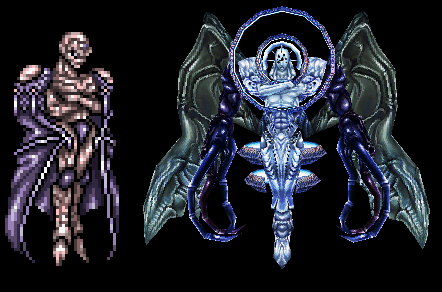
- When Biran and Yenke claim they'll make a statue of Yuna with a big horn on it, it just might be a reference to FF9 in which summoners actually do have horns. Summoners in other games also have horns, but wear them as hats. (sent by Michael Robinson)
- Lulu's dolls are a big crossover. They can look like Moogles, Moombas, Cactuars, Cait Sith from FF7, PuPu from FF8, or the Onion Knight from FF3. Moogle, Moomba, Cactuar, Cait Sith, PuPu, Onion Knight. (pictures sent by baby-t)
- Kimahri's has a weapon named "Highwind". Highwind is also the last name of Kain the Dragoon in FF4, the middle name of King Tycoon in FF5, and Cid's airship and last name in FF7. (sent by Michael F.X. Durant)
- Auron has a weapon called "Matoya's Blade", a natural reference to the witch from FF1.
- When you first go to Luca, during the FMV at one point you can hear the FF9 tune that plays when "I Want to Be Your Canary" first starts. (Brahne Appears--The Play Begins on the FF9 OST Plus album.) (sent by Purity)
- After the Warrior Monks have taken over guard duties in Luca, a man wearing a green tunic walks around in the circle area with egresses to the stairs and the cafe (where the little girl with the red balloon is). He says that he asked out a Warrior Monk girl in the cafe, but she called him a "spoony bard." This is a reference to FF4, when Edward was called the same by Tellah (sent by Mark the Office Troll)
- One of Yuna's weapons is called "Laevatein". This is possibly a reference to good old Leviathan. (See also: Name Origins: Items) (sent by brother_zeal)
- There is a similarity between Alexandria Castle from FF9, and the statue in the middle of Luca in FF10 and FFX-2. Both have a characteristic spire in the middle. (sent by Nick V)
- There is a town named Luca, which is also the name of the dwarf-king's daughter in FF4. (sent by Jordan)
- One of Tidus' weapons is called Lionheart, named after Squall's best weapon in FF8.
- Dresspheres & Weapons (sent by MoogleFan, CheetaRyan, Semysane Titus, Sami Hietanen)
- Yuna's Warrior dressphere uses Tidus' sword "Brotherhood". (Her victory pose is also copied from Tidus)
- Rikku's Warrior dressphere uses Tidus' sword with Firestrike and/or Icestrike (Flametongue, Double Edge, etc.)
- Yuna's Dark Knight dressphere uses the Tidus' ultimate weapon "Caladbolg".
- Rikku's Dark Knight dressphere uses the Auron's ultimate weapon "Masamune".
- Yuna's Black Mage dressphere uses Yuna's ultimate weapon "Nirvana".
- Rikku's Black Mage dressphere uses Yuna's staff with a special ability (Laevatein, Astral Rod, etc.)
- Paine's Black Mage dressphere uses Yuna's staff with sensor or magic augmentation (Enchanted Rod, Ductile Rod, etc.)
- Yuna's White Mage dressphere uses Yuna's default weapon "Staff".
- Rikku's White Mage dressphere uses Yuna's staff with strength augmentation or counter ability (Spiked Rod, Wind Rod, etc.)
- Paine's White Mage dressphere uses Yuna's staff with elementalstrike or status effect (Malleable Staff, Rod of Flame, etc.)
- Yuna's Samurai dressphere uses Auron's blade with a status effect (Soundless Scream, Corruptor, etc.)
- Rikku's Samurai dressphere uses Auron's default weapon "Blade".
- Yuna's Mascot dressphere uses a Moogle for the costume and a Moomba for the doll weapon.
- Rikku's Mascot dressphere uses a Cait Sith for the costume and a PuPu for the doll weapon.
- Paine's Mascot dressphere uses a Tonberry for the costume and a Cactuar for the doll weapon.
- Yuna's Trainer dressphere uses the same dog as Yojimbo's.
- When Yuna in her Songstress dressphere starts dancing, she'll say "Hey! Eyes on me!". This is a reference to the theme song of FF8, "Eyes on Me" by Faye Wong.
- Paine's victory pose in the Dark Knight dressphere is similar to Cloud's from FF7.
- If you match up all the monkeys in the Zanarkand Dome, you get an accessory called the Soul of Thamasa, which has the Auto-Ability Magic Booster, which makes magic spells more powerful, but doubles MP cost. In FF6, Thamasa was a little town whose inhabitants were good at casting magic. This also existed in FF8, but was mistranslated as Samantha Soul. (sent by Shigmiya64)
- Most of Shuyin's attacks are Tidus' overdrives from FFX. (sent by Alexandre Brault)
- Terror of Zanarkand = Blitz Ace (Ace of the Blitz)
- Force Rain = Energy Rain
- Hit & Run = Slice & Dice (Charge & Assault)
- Spinning Cut = Spiral Cut (a nod to Spira's spiral of death, maybe?)
- Also, during his Terror of Zanarkand attack, the Blitzball he kicks is Wakka's ultimate weapon, World Champion.
- The garment grid "Bum Rush" is also Sabin's (FF6) most power Blitz. (sent by Michael Sams)
- Yuna's necklace in her default outfit is the same as the "J/T" symbol shown prominently in FF10, especially on Tidus' pants, Jecht's tattoo, and the fight versus Braska's Final Aeon.
- If you check Shinra's bestiary and view Ultima Weapon's info, the last line reads "Whatever you do, don't call him Atma". This is in reference to the Atma Weapon boss in FF6, which was a mistranslation of Ultima Weapon. (sent by PaleDim)
- The boss King VERMIN! in the secret dungeon at the Mi'ihen Highroad could be a reference to FF7 where Barret calls President Shinra "King Vermin!" Information for the boss can be found Shinra's Bestiary, along with a description and a sentence that sounds like something Barret would say: "Its fire attacks are a dead giveaway that it's in charge, Foo'." (sent by Shana)
- When you save a game in FF X-2, you can find the blue alien Pupu on the memory card representing the file. (sent by Moogle-Chan)
- Rikku occasionally makes the comment "Booyaka" if you make her use certain abilities. Sounds a bit similar to a catchphrase a different hyperactive FF girl... Selphie.
- FF9's Benero makes an appearance as an Al Bhed being interviewed by Shelinda.
- FF9's Cinna makes an appearance as someone not willing to part with his favorite hammer.
- At the end of FFX-2, after the scene in the Farplane Depths involving Paine's past and Paine's Sphere, if you talk to Shinra on the Celsius, he mentions that he's found evidence of a planet energy in the realm of the farplane, one that could be used to power cities day and night. Shinra then laments that it would take generations to refine the process and both he and Yuna lament that they won't be around to see it. This presents a similar correlation in the fact that A) Shinra is the name of the malevolent electric company in FF7 and B) the planet energy he speaks of is similar to the Lifestream, and the city as Midgar. (sent by Dalton of Zeal) Here is the full text of the speech:
SHINRA: "Aha..."
YUNA: "What are you looking at?"
SHINRA: "Farplane data. The more I study it, the more fascinating it gets. There's limitless energy swirling around in there."
YUNA: "Limitless energy?"
SHINRA: "The life force that flows through our planet...I think. With a little work, we could probably extract the energy in a useable form."
BROTHER: "Sweet!"
SHINRA: "Of course, that'd take generations."
BROTHER: "That's no fun!"
BUDDY: "Well, still, it is something worth shooting for."
YUNA: "Think how much Spira would change if we ever got it to work! Maybe one day we could build a city full of light, one that never sleeps!"
SHINRA: "No doubt about it."
YUNA: "Just imagine! But I'll never get to see it...will I..."
(Shinra shakes his head, meaning "no")
BROTHER: "Shinra! Don't make Yuna sad!"
SHINRA: "Right. My bad."
- Another allusion to lifestream can be found in the Rin's Machina Mystery sidequest. There are several different culprits in this scenario, depending on what evidence you see. If Yuna pins the haywire machines on Rin, they will discuss how Rin tried to cover up the event so people would not be afraid of machina. The final lines of this scene are as such:
RIN: If word got out that machina pose a danger, people would fear them and stop using them.
PAINE: So Yevon's not alone in sweeping things under the rug.
RIN: I firmly believe that machina are an indispensable part of Spira's development. Even if there is another incident, I intend to conceal the evidence.
YUNA: You really think people will follow you that way?
RIN: I am not alone in my thinking. We are researching ways to extract the vast energy that sleeps in Spira, and use it to power machina.
PAINE: You're a jackass.
RIN: I will take that as a compliment.
- Cornelia shares the same name as the starting town in FF1 (Corneria) and the lead in the play "I Want To Be Your Canary" in FF9. However, the name was more likely taken from King Lear; see Ex-Crossovers. (sent by Ambyrr22)
- Cid is in love with a girl named Hilda, the owner of the Steaming Sheep restaurant. Cid and Hilda Fabool were a married couple in FF9.
- For the Rank 4 missions you need to get magicite. In FF6, magicite is a stone/crystal shard that let you summon Espers. (sent by JoeE0091)
- The beginning weapon series for the game are "Onions", e.g. Onion Dagger, Onion Staff, Onion Sword, etc. There's also an easy quest in Windurst for a group of children calling themselves the "Star Onion Brigade". Both of these are obvious references to the "Onion Kid" class in FF3. Also, The Star Onions is the name of the band who released an arranged album of FF11 music. (sent by Mesic)
- The strongest weapon skill for hand-to-hand weapons is called Final Heaven, which has been used as a limit break for Tifa from FF7 and Zell from FF8 respectively. They are both fighter characters (hands/gloves for weapons). (sent by Fenrir)
- The strongest weapon skill for sword weapons is called Knights of the Round, which is the strongest summon in FF7. (sent by Fenrir)
- There is another sword weapon skill named Spirits Within, the subtitle of the first Final Fantasy movie. (sent by Fenrir)
- The Ahriman has an attack called "Eyes on Me", which is also learnable by the Blue Mage. This is named after the title song of FF8. (sent by Pook)
- The Artifact Armor (level 50-60) for each job class strongly resembles the costumes for the corresponding job class in the NES era. For example, the summoner's armor is a green robe with a horn, just like FF3. The white mage has a white cap and body armor lined with red triangles.
- Every server that clients play on is named after a famous summon. Here is a current list of the 34 servers:
(Sent by Pook)
Other than the many references in the World of Ivalice, FF12 has some interesting ones:
- You can race Rikken in Balfonheim; the race is very similar to Vivi's race in FF9, which also consisted of alternating A and B. In addition, Raz, one of the racers, bears more similarities to Vivi: he's short and constantly tripping over his own feet.
- One of the clan ranks is Knight of the Round, the name of the strongest summon in FF7.
- Two of the names of Resistance fighters in the battle with the Bahamut are Orthros (aka Ultros from FF6) and Galuf-Val (from FF5). Orthros also appears as a mark, though as a slime, not an octopus.
- The Clan Primer description of the Pit Fiend monster states: "A myth counts this being as one of the warriors set to defend the Jade Passage to the Devil's Palace." This is a reference to FF2, where the Jade Passage led to Pandemonium, which in legend is the home of demons.
- The second page of the Clan Primer description of the Aeronite says the following: "The airship armadas of one far-off land display a blood-red wyvern wing as their heraldic crest. In this land, colors are used to distinguish class, with red being most auspicious and thus highest in rank, used both for the royal family and, it being a military state, for their elite fleet. This Redwing Armada is said to be the strongest in the world, and serves as an excellent deterrent to invasion." This is a reference to the Redwings from FF4 (which were also mentioned in FFTA).
- Gilgamesh and Enkidu return from FF5, this time as a mark (though Enkidu now resembles a dog rather than a bird). In addition, Gilgamesh holds several swords, all of which reference other FF and Square-Enix games. They include:
- The Excalibur from FF5.
- Cloud's Buster Sword from FF7.
- Squall's Gunblade from FF8.
- Tidus's Brotherhood from FF10.
- Odin's Steel-Cutting Blade (Zantetsuken).
- Loto's Legendary Sword from Dragon Quest 1-3.
- The Tournesol from FF12.
- The Wyrmhero Blade from FF12 (this is the one left behind after the fight; when examined, it says it "appears to be just an ordinary sword of legend").
- One of the marks is Ixion, an Aeon from FF10.
- The description of Omega Mark XII has him as an "Ancient Warmech". This is possibly a nod to FF1. FF1's "ultimate" monster was indeed called Warmech.
- The description of the Earth Tyrant mentions eight "great wyrms". This is possibly a reference to FF6, where a sidequest involved beating eight dragons scattered around the world.
- One of the airships is named Xezat Surgate, a character in FF5.
- One of the airships is named Queen Hilda, a reference to FF9.
- A bangaa in Rabanastre has a similar message throughout the game, where he talks of his friend counting things (originally cobblestones). However, at one point in the game he says this: "My friend says that o'er 430 revelers came through the Southern Plaza during the big fete! But even if you count the bards... 'Course, he could be countin' the spoony bards, too. That would be another matter altogether." A reference to FF4's famous "Spoony Bard" line.
There are many FF series crossovers in FF Tactics besides the obvious one of Cloud and Aeris, specifically in the Proposition section. Here's a list! The parentheses say what the crossover is, and which game it's from. U.L. stands for "Unexplored Land".
- Adamant (Monster, entire series)
- The Adamantaimai was found in the Proposition, "Terror Of Assault Cave".
- Anna (Character, 4)
- She and Gilbert write love letters to each other in "Letter To My Love" and "Joyous Song For You".
- Assault Door (Enemy, FF4)
- The Assault Door was found throughout the Sealed Cave in FF4; it was used extensively in "Minimum's Melancholy" Propositions.
- Bacchus' Wine (Item, throughout series)
- The wine is called "Vaccas Liquor" and is mentioned in the Proposition, "Battle! Demon Lylis!"
- Baron (Place, 4)
- In FFT, the Crystal Tower U.L. was supposedly part of Baron Castle. The Castle of Trials U.L. was purportedly Baron's military school, where the Red Wings (from 4) graduated.
- Blackjack (Transportation, 6)
- Setzer's ship is a casino ship in the "Wandering Gambler" Propositions. Setzer himself shows up.
- Calcobrena (from FF4)
- The Calcobrena were Luca's dolls which became possessed by Golbez and attacked Cecil. In FFT, the "Calcobrina" Treasure was just a doll.
- Chaos (Monster, 1)
- The Shrine of Chaos is a U.L.
- Chimera (Enemy, entire series)
- The Proposition "At The Hilltop Mansion" has an enemy named Kimera.
- Chocobo Forest (Place, 3, 4, 5, 6, 8)
- Adequately represented by the U.L. "Chocobo Forest".
- Corneria (Place, 1)
- A possible mention as the woman Cornelia, in the Proposition "Rescue of Cornelia".
- Dorga (from FF3)
- Has a ship named after him in the Proposition "Doga Salvage".
- Echo Plant (from FF5)
- There's a "Whisper Plant" found in "Destiny Of The Company". The Echo Plant was used by Zeza to communicate with Galuf in FF5. A similar device, the "Echoer" harp, was used in FF4.
- Elder Tree (from FF3)
- The tree used by Hyne to build his flying castle was rightly called Yggdrasil, the Life Tree (a term from Norse legend used in many RPGs). The "Parasite Tree" Treasure leeched off the "Yugudoracil" while the "Himka Cliff" Proposition led our intrepid explorers right to the "Yugdrasil". (The first spelling in this entry, despite all the extra consonants, is the correct one. 8-))
- Enterprise (Transportation, 3 and 4)
- Another airship turned into a shipwrecked trade ship in the Proposition "Larner Channel Waves".
- Excalipur (Weapon, 5)
- Gilgamesh's very weak sword is ressurrected as the "Excalipar" Treasure, which nevertheless says it's still a fairly strong sword, a patent lie.
- Gysahl Greens (Item, entire series)
- The Proposition "Chocobo Restaurant" describes a restaurant named Gizarl's.
- Fargabaad (Place, 3)
- The U.L. "Falgabird" accurately describes this Magic Knight town from 3.
- Forbidden Land Eureka (Place, 3)
- Although a land of monsters and treasure in FF3, the Tactics U.L. is a former capital of an ancient kingdom.
- Gilbert (Character, 4)
- He and Anna write love letters to each other in "Letter To My Love" and "Joyous Song For You".
- Gisahl (Place, 3)
- The "Chocobo Restaurant" (in the Proposition of the same name) is called Gizarl.
- Mosfungus (Enemy, 5)
- In FFT, Mosfungus is a deadly poison. The Mossfungus in FF5 is an enemy that can be found in the Cleft of Dimension. (sent by UltimaWepn)
- Mount Gulg (Place, 1)
- The Proposition "Girl In Gulg Volcano" takes place here. (Another instance of Engrish.)
- Highwind (Transportation, 7)
- The Highwind has been transformed into a trade ship which was shipwrecked (like every other ship in Tactics) in the Proposition "Salvage The Highwind!"
- Jade Portal (Place, 2)
- The description for the Shrine of Chaos says that Jade, king of Hell, was buried nearby. (The Jade Portal leads to Hell, by the way.)
- Lonka (Place, 5)
- In 5 it was an ancient civilization. FFT mixes many different things in it; the Mirage Tower (U.L.) supposedly leads from a Lonkan castle to earth (there was indeed a flying Lonkan Ruins in 5, but this is represented by the U.L. "Ronkan Ruins" which accurately describes the Ruins from 5.) Matoya (from the Matoya's Cave U.L.) supposedly lived in Lonka as well.
- Lugae Borg (Enemy, 4)
- The form Dr. Lugae transforms into is recreated here as an item horribly translated as Yugeivogue.
- Materia (Term, 7)
- The four Materia Treasures are references to FF7, but it claims that Materia came from Salonia, a place in FF3. Red materia was used for summons, blue for support, and Black and White Materia were part of FF7's storyline.
- Matoya (Character, 1), Matoya's Cave (Place, 1)
- Matoya's Cave is a U.L., but in FFT Matoya is male and worked in the Lonkan Empire. See Lonka.
- Mindu (Character, 2)
- The "Minu Orb" Treasure, which supposedly contains the soul of the first magician, Minu (aka Mindu) is a reference to the magician from FF2.
- Tower of Mirage (Place, 1)
- According to FFT, the U.L. Mirage Tower connects the Lonkan castle to earth. See Lonka.
- Citadel of Trials (Place, 1)
- A nice mix-up in the description. Mount Ordeals (a similar place in 4) was where Cecil went to become the Paladin, whereas Citadel of Trials was actually from 1 and held the Rat's Tail. According to FFT, the Castle of Trials (U.L.), another name for Citadel of Trials, was actually Baron's military school, where the Red Wings graduated from. See Baron.
- Pandemonium (Place, 2)
- The description for the U.L. Pandemonium is identical to its role in FF2 (as Pandaemonium).
- Phantom Train (Place, 6)
- FFT calls it the Magic Train (U.L.) and also calls it the "carrier of the dead", an accurate description.
- Salonia (Place, 3)
- The four Materia Treasures supposedly came from here (although materia didn't exist till FF7. 8-))
- Sand Worm (Enemy, entire series)
- Discovered in Proposition "Ruins At Bed Desert".
- Semitt Falls (Place, 2)
- Accurately described in the U.L. "Semitt Falls" as a place in the Paramecia Empire which holds Mithril.
- Setzer Gabbiani (Character, 6)
- Setzer and his casino ship, Black Jack, show up in the "Wandering Gambler" Propositions.
- St. Elmo's Fire (from FF7)
- The enemy in the Underwater Junon Reactor which yields the Guide Book if Morphed (it's a long story) uses a special attack called St. Elmo's Fire. The real St. Elmo's Fire is a weather phenomenon experienced by sailors which only occurs during electrical storms. It's also a Treasure in FFT.
- Sylx Tower (Place, 3)
- The Crystal Tower U.L. is supposed to be the Sylx Tower, but in FFT it was supposedly part of the Baron Castle. See Baron.
- Tower of Babel (Place, 4)
- The Tower of Babel U.L. reaches from earth to heaven (FF4's Tower of Babel did indeed reach from the underground to heaven). FFT also calls it "Giant's Tower" - a reference to the Babel Giant from 4.
- Tozas (Place, 3)
- The U.L. "Touzas Village" more or less describes the village of midgets (which it calls Lilliputians, a reference to "Gulliver's Travels") from FF3; however, it adds that it was liberated from dictatorship by a giant, Atlas, who doesn't appear in the game.
Like FFT, the huge inventory, mission list, and quest items contain lots of references to other FF games. Note that some more crossovers are indicated in the World of Ivalice. To whit:
- Materite (a quest item and the subject of a few missions) is basically "Materia ore". Materia is from FF7. Also, silvril is probably just a mistranslated "mithril", and the missions for it echo the mission for getting mithril in FF2.
- The head of the Borzoi clan was actually called Guzco in the Japanese version - a reference to the thief from FF3.
- In Mission 81 - "Redwings", you search for the Redwings clan, who is led by a Dark Knight. This is a reference to the airship fleet in FF4 which was led by Cecil, also a Dark Knight. Jaime Sanchez mentions that even though Grissom, the Redwings leader, is identified as "Dark Knight" if you examine him, his sprite and moves are that of a Paladin, further underlining the Cecil connection!
- The Falgabirds, leaders of the Redwings, are actually the four Fiends/Chaoses from FF1 and FF9. However, rather than being unique characters, they're just generic monsters (Lich is a zombie, Malirith is a lamia, Kraken is a flan, and Tiamat is a thunderdrake.) The name "Falgabird" is also a reference to the town Fargabaad in FF3 (it was translated this way in FFT as well, see above).
- The "Free Muscadet" mission has you coming up against three characters: a Templar named Silverlock, and two assassins named Celia and Redy. This is a remake of two fights in FFT against Elmdor (who has silver hair), and his assassins Celia and Lede.
- In the "Free Bervenia" mission, you come across Guzco again, who's turned into a Lucavi (here translated as Rucavi), a crossover from FFT. He's also abetted by two Apandas (actually ahrimans) and two Archaeodemons (actually icedrakes).
- In one of the "ForeignFiend" missions, you go up against a Queen Lamia (just a renamed Lamia), from FF2.
- In another one, you fight an Adamantoise (actually a renamed Toughskin).
- In yet another one, you come up against an Ochu and a Neochu. Ochus appear in the rest of the FF series, but here it's just a renamed Malboro. Neochu is from FF1.
- In one battle, you fight a group of Lamias known as Sandy, Cindy, and Mindy, the names of the Magus Sisters.
- The "Magewyrm" mission has you pitted against a dragon named Garland - a boss in both FF1 and FF9. (I got that from a Japanese FAQ and don't recall if he was translated that way in the English version.)
- The "Missing Meow" mission has you fighting a Master Coeurl (just a renamed Coeurl), a reference to the monster from FF10.
- "The Worldwyrm" puts you up against a thunderdrake named Ogma; after beating him, you get an item called Ogma's Seal. This is probably a reference to the Omega Weapon from the rest of the series; after beating them you usually get something called "Proof of Omega", a useless item.
- "Gulug Ghost" makes another mention of good old Gulug (Gurgu) Volcano from FF1 and FF9.
- "Mirage Tower" mentions a mirage tower in the middle of the desert - definitely an FF1 reference.
- "Falcon Flown" references a falcon named "Hyperion", which was the name of Seifer's gunblade in FF8.
- Mysidia Alloy (both a quest and an item) is a reference to the town of Mysidia in both FF2 and FF4.
- There's a reference to a blacksmith named "Gilgame" in the missions "Blade & Turtle" and "Armor & Turtle". This is probably a reference Gilgame Cave in FF5, where Gilgame, a turtle, attacked you.
- In the Japanese version, there were references to the Calcobrina from FF4 and the M.Machine from FFT. I haven't corroborated this yet though. (sent by Cactuberry)
- The Buster Sword, Apocalypse, and Hardedge are from FF7. The Onion Sword is from FF3. The Chirijiraden, Nagrarok, and Materia Blade are from FFT, as is Osafune (where it was called Bizen Boat). Kain's Lance is from FF9, which itself is a reference to the character Kain from FF4. Excalibur 2 is from FF9 as well.
- Although there's no Odin summon in the game, there is an item called Odin's Lance.
- There are several items that reference creatures from the series: Ahriman Eye and Wing, Chocobo Skin, Bread, Gratin, and Egg, Malboro Wine, and Tonberry Lamp.
- The Mindu Gem is a reference to Mindu from FF2 (see Minu Orb in FFT, above).
- The Calling Gun is a reference to FFT's Magical Gun treasure, and also to the Demon Gun from FFU (or vice versa).
- The Kiddy Bread and Grownup Bread is a reference to the Kid's Bread and Adult's Bread from FFT.
- The Gulug Ghost mission might be a reference to the FFT proposition "Girl in Gulug Volcano", the history of which reports the party running across the spirit of a girl. (sent by Da Lovett)
- In mission number 59 (Sketchy Thief) you have to recover someone's sketchbook from a thief. When you get there, the thief is surprised that a monster materialised from it. This is a reference to the FF6 character, Relm, whose special ability Sketch could duplicate monsters and make them fight for you. (sent by Magma)
- In mission #179 (Scarface), the mission was put up by "Tingel, Knight". This was a throwback to FFT where there are 3 Tingels - Izlude Tingel, Meliadoul Tingel, and Vormav Tingel. (sent by Ryan Hawk)
- When Marche gives Mewt a gift for "Gift Day", he says he's bringing him a Lugaborg. This is a reference to the robot Dr. Lugae turns into in FF4. (sent by Some Person)
- Two of the random names for characters are Yenke (from FF10/FFX2) and Hildegard from FF9 (probably from Hilda Garde).
- One of the weapons for the paladin is the Lionheart, which is the name of Squall's best weapon in FF8.
- Makenshi's Sword Dragon could be connected to the Mist Dragon summon from FF4, especially considering the Sword Dragon is summoned using Mist, and the Dragon turns into mist when you fight it near the start of FF4. They look kinda similar too... (sent by dpgemmell@gmail.com)
- A malboro can be seen in a stew pot.
- A PuPu can be seen in the crystal ball on Jane's bridge.
- Cid is turned into a frog in one episode. This also happens to the Cid in FF9.
- In Marr's Pass, there is an old man called Cecil who says that back in his day he used to be quite a ladies man. This is a refrence to Cecil from FF4, who had many girls associated with him. (sent by Juho Penttilä)
- There is a character named Leon who became the Black Knight after losing his memory, reminiscent of FF2. (sent by Juho Penttilä)
- Magic is learned from magicite, much like FF6. (sent by Juho Penttilä)
- There is a moogle named Artemecion traveling with an occasionally encountered band of thieves. There is a moogle by this name in FF9. (sent by Fenrir)
- Stiltzkin, a moogle from FF9, appears throughout the game. First to train you, then at Miasma streams, and finally at Mag Mell.
- Fiona, the FFCC princess of Alfitaria, has two different eye colors. Her right eye is green and her left eye is blue; exactly the same as Yuna in FF10/X-2. (sent by Ryan H)
- Extra Dungeons:
Each time one of the four orbs is revived, a secret dungeon is unlocked which contains many crossover bosses.
- Earthgift Shrine: This place has five floors with four bosses, all from the Dark World in FF3 - Ahriman, Echidna, 2-headed dragon, and Cerberus.
- Hellfire Chasm: Ten floors with four elemental fiends from FF4 - Scarmiglione, Cagnazzo, Barbariccia, and Rubicante.
- Lifespring Grotto: Twenty floors with four bosses from FF5 - Gilgamesh, Atomos, Omega, and Shinryu (God Dragon).
- Whisperwind Cove: Forty floors with four bosses from FF6 - Typhon (Chupon), Orthos (Ultros), Phantom Train, and Death Gaze.
- The random names in the GBA version of FF1+2 are chock-full of references to other FFs. The list follows:
- Warrior Names:
Giott (Character, 4); Sasuun (Sassoon: Place, 3); Doma (Place, 6); Argus (Character, T); Desh (Character, 3); Banon (Character, 6); Arus (Character, 3); Leo (Character, 6); Baron (Place, 4)
- Thief Names:
Baku (Character, 9); Biggs (Character, 6, 7, 8, 10, X-2); Sarisa (Character, 5); Wedge (Characer, 6, 7, 8, 10, X-2); Gerad (Character, 6); Puck (Character, 9); Kelga (Character, 5); Blank (Character, 9); Daryl (Character, 6)
- Monk Names:
Maduin (Character, 6); Duncan (Character, 6); Walz (Place, 5); Arvis (Character, 6); Drogan (Character, 5); Marcus (Character, 9); Gorn (Place, 5); Owzer (Character, 6); Owain (Character, 6); Cinna (Character, 6)
- Red Mage Names:
Gill (Character, 5); Lola (Character, 6); Tot (Character, 9); Mid (Character, 5); KluYa (Character, 4); Lalibo (Character, 5); Elayne (Character, 6); Duane (Character, 6); Yura (Character, 6)
- White Mage Names:
Kuku (Character, 6); Mikoto (Character, 9); Ruby (Character, 9); Elia (Character, 3); Luca (Character, 4); Sara (Character, 1, 3, 9); Noah (Character, 3); Jenica (Character, 5); Sarina (Character, 9)
- Black Mage Names:
Nina (Character, 3); Kokkol (Character,4); Koko (Character, 5); Topapa (Character, 3); Homac (Character, 3); Zok (Character, 5), Gilles (Character, 5); Gungho (Character, 5); Delila (Character, 3); Stella (Character, 5)
- In the B10 level of the Lifespring Grotto, one of the dancers in the first line says "I'm hoping to play the princess of Cornelia in 'I Want to be Your Canary." This is a reference to the play in FF9. (sent by Steven Hall)

- Another one, from the second dance line, says "I have to keep practicing if I want to clear the Tantalus Theatre Troupe tryouts." A third dancer asks "Have you heard of the Tantalus Theatre Troupe?" These are in reference to the theatre group from FF9.

- The bonus game of FF2 refers to Richard's adopted son as Kain. They both share the same surname (Highwind) and are both dragoons. Kain has blonde hair, just like in FF4, and mentions that he is following in his father's footsteps.
- In the Hide and Seek Room of Whisperwind Cove, a kid asks if you've seen a Trance Kuja figure anywhere. Kuja is the primary antagonist in FF9, and Trance Kuja is his final boss form.
- In the Hide and Seek Room of Whisperwind Cove, a kid mentions how cool is his Mecha Bahamut doll.
- In the Hide and Seek Room of Whisperwind Cove, a kid asks where he can find his Tetra Master cards. Tetra Master is the name of the card game in FF9.
- The Princess, soon-to-be-queen, of Fynn is named Hilda, the same as Cid's wife in FF9. (sent by Kevin Lam










































